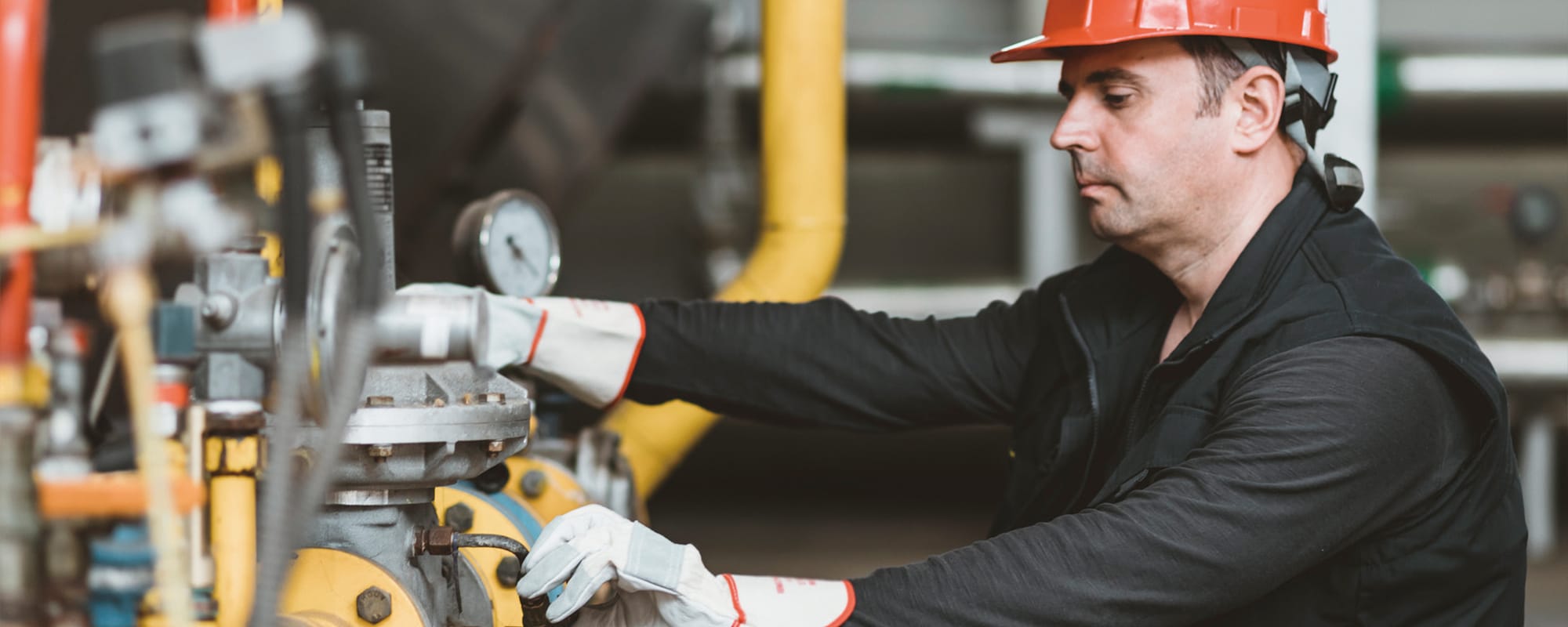In this Ask the Expert feature, OMRON market development manager and panel solutions specialist, Dave Breckell, discusses how condition monitoring solutions for motors and control panels support predictive maintenance strategies that mitigate downtime, reduce costs, hasten response times for critical issues and reduce equipment failures.
In this installment of RS’s Ask the Expert Series, OMRON’s market development manager and panel solutions specialist, Dave Breckell, talks about how condition monitoring solutions enable predictive versus preventative maintenance. He addresses how predictive maintenance reduces downtime and overall costs for motors and control panels and introduces condition monitoring solutions from OMRON that support predictive maintenance.
Hi David. Thank you for taking the time to speak with us.
Good afternoon, everyone. My name is Dave Breckell. I’m a market development manager for OMRON and I’m one of our panel solution specialists here in the U.K.
Condition monitoring is all about maintenance, which can fall into three categories: reactive, preventative and predictive maintenance. Given that the first one is not really an option for running a successful facility, what can you tell me about the main differences between preventative and predictive maintenance?
Preventative maintenance is the more traditional, time-based maintenance strategy. It takes place on a fixed schedule regardless of the wear and tear, condition or usage of the machine. Typically, there will be a scheduled downtime during which a maintenance engineer or technician will take the machine offline and go through a prepared checklist. Certain components might be cleaned and repaired and others might be preventively or preemptively replaced. This is a common strategy, and it does reduce downtime, but it’s quite costly and time consuming and it requires skilled maintenance technicians or engineers to perform the actual checks.
Predictive maintenance is condition-based monitoring. It uses IoT-enabled sensors to continuously collect and analyze real-time machine data and identify performance issues long before they lead to failures. This approach allows you to schedule maintenance when it’s most convenient and cost effective, reduces the amount of downtime required for inspection and testing, reduces the number of repairs and replacement parts and frees up your maintenance technicians and engineers for other tasks. So, predictive maintenance means less downtime and less cost for the customer.

In terms of predictive versus preventative maintenance, one of the main differences is that, with predictive maintenance, you don’t necessarily need to take a machine offline if it’s working correctly because your sensors are telling you that everything is okay. Is that right?
That’s correct. The condition monitoring data used for predictive maintenance can also help you identify potential issues at an earlier stage than with preventative maintenance, as that scheduled maintenance might only be every 12 or 18 months, but you can check the IoT sensors as often or as little as you like. So, you might identify small issues on a monthly basis, but doing so will allow you to solve any such issues long before the machine fails and disrupts production.
Condition monitoring solutions let you access process and sensor data 24/7, so they seem like a good starting point for a successful predictive maintenance strategy. But I’d guess it’s not as straightforward as that. So, how would you explain how to bring the data from the equipment or process centers through to the enterprise level or to the analytical and decision layers?
There are a number of different condition monitoring products and solutions on the market, but from a data analysis point of view, there’s really two types. The first type uses cloud computing, which means that the data is collected locally on the machine and then transmitted through the internet to remote servers in the cloud where it’s processed and analyzed before being sent back to the maintenance or factory management system.
The second type uses edge computing, which means that the data is collected and processed at the machine level, so either in the control panel or on the machine itself. In this situation, you’re only really outputting the actual result — for instance, the condition of the machine and whether it needs maintenance. This is what we develop at OMRON.
Edge computing technology has a lot of advantages. It’s more flexible than cloud computing technology because it doesn’t require anywhere near as much IT infrastructure since it’s processed locally on the machine. So, it’s much easier to start out small and to retrofit existing equipment. It’s also more secure because your data doesn’t leave your factory; it’s not going out into the internet where, even with the proper protections in place, you can have issues with firewalls and data connections. Another benefit to edge computing is that local data processing doesn’t require a 24/7 internet connection, which is another thing that can cause issues with cloud computing technologies. Plus, it reduces the amount of factory data that has to be processed, reviewed and responded to because it only sends the judgement or the actual results to the factory network rather than moving the raw data along 24/7. OMRON uses widely available industrial protocols, such as Ethernet/IP and Modbus TCP, to communicate with factory management and maintenance systems.
It looks like retrofit solutions are quite a big opportunity and can spare the expense of a major overhaul. Are edge computing solutions a good starting point for realizing that benefit?
Yes, definitely. Seventy-five percent of businesses experience unplanned downtime, and the cost of that downtime can easily total tens of thousands of dollars. Unplanned downtime can bring an entire production line to a standstill and, if it’s part of a larger process, you could end up with a situation where you produce substandard parts or a product that doesn’t meet your quality requirements. Retrofitting your equipment with edge computing condition monitoring technology that locally processes your machine data makes for a low barrier to entry to migrating to a predictive maintenance strategy.
To start small, on a site level, we’d find something that was critical to the process, usually something that runs 24/7, like a motor, fan or pump system. We would then build an edge computing condition monitoring system around that device that could either feed data to a PLC or, as time goes on, to a scaled-up facility management and maintenance system.
Motors have a big influence in terms of the amount of efficiency and throughput you can achieve, especially in applications with production lines and conveyor systems. How can you tell when motors aren’t working efficiently? What signs do they exhibit?
The condition and performance of a motor generally degrades over time due to the aging process, and there are a lot of situations in which they’re running 24/7. There are also lots of things that can cause motor failure. For example, there can be issues with an imbalance on the load, or bearings can seize up or break down. Another common issue is insulation resistance breakdown. Rotors and starters are equipped with insulation, and it can break down due to excessive heat or condensation in the motor causing corrosion. This breakdown will not only cause the motor fail but will introduce the risk of electric shock as well. And if the motor itself is overloaded, it can generate excess heat and vibration.
Condition monitoring sensors let you look at things like the waveform, and if there’s an issue, you can use current analysis to determine if there’s going to be a motor failure at a very early stage, long before it might be made obvious by motor heat or noise. For example, a load imbalance on the shaft would cause a gap between the rotor and the starter, and that gap would cause current variances that could be detected by condition monitoring sensors. Once you knew about the current issue, you could measure the frequency of the components inside of the motor to identify the error and then correct the imbalance. Surface temperature and vibration sensors can also be useful for detecting motor inefficiencies.
Insulation resistance breakdown also damages motors and creates a risk of electric shock. But this issue has traditionally been quite difficult to check. As such, motors with suspected insulation resistance breakdown have long had to be taken out of service and disconnected so that a skilled engineer or maintenance technician could put an insulation tester across from each phase, or possibly put 1,000 volts in, to check it out. Modern, IoT-based condition monitoring sensors, on the other hand, can perform this check in real time. As long as the motor isn’t running, we can apply 50 volts to some models and use a current transformer on others to check it on an almost hourly basis, pick up that degradation much earlier and get a lot of other insights into the condition of the motor. For instance, OMRON’s K6CM Series condition monitoring solutions can detect all these issues, analyze the data very quickly and locally and then send the results to your factory maintenance system.
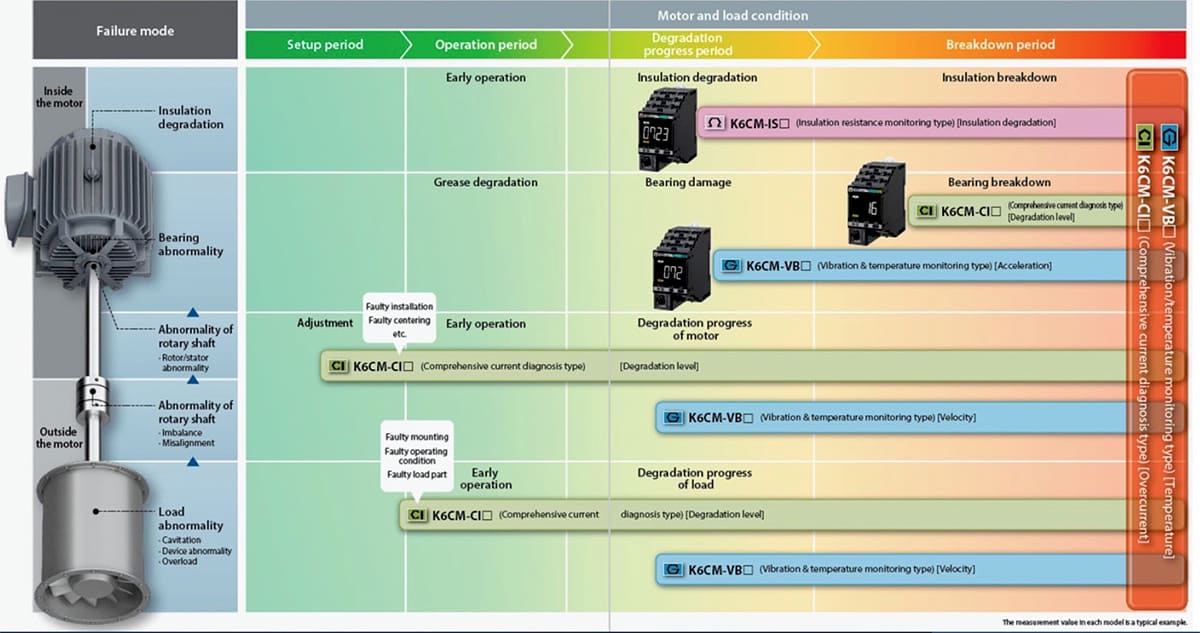
So, these devices are constantly monitoring the same conditions that you used to have to take the motor offline and remove it from the system to check?
That’s correct. One of our condition monitoring solutions, the K7GE, uses 50 volts DC, which is much safer than the 500–1,000 volts typically used. It’s permanently wired into the contactor or the inverter that drives the motor, and as long as it receives a signal saying that the motor is de-energized, it can apply 50 volts. This can be done remotely, through software, or at the machine and then send the results to your factory maintenance system, essentially automating the test process. OMRON’s K6 and K7 Series condition monitoring devices de-skill the process, and you can use them as often as you want, so you can have very regular checks instead of six monthly, twice a year or even yearly.
One thing that is often overlooked when it comes to maintenance is the actual control panel itself. Control panel inspection is usually part of a broader preventative maintenance schedule, but we know that issues can arise quickly and have a hugely damaging impact. How can factory personnel address some of the issues that can arise in control panels?
The temperature within a control panel is critical to its long-term reliability. But you’ll often find that the temperature inside of a control panel is 10 to 15 degrees higher than the ambient temperature of the facility it’s in. And a typical factory can reach 30°C, 35°C or maybe even 40°C in some climates during the summer, so you could have 50–55°C inside the control panel.
These elevated temperatures have an enormous effect on component longevity. Virtually every electronic component has a rated operating temperature range — for instance 0°C to 70°C, the standard commercial range, or -40°C to 80°C, the standard industrial range — and as a rule of thumb, every 10 degrees above that limit that a component is consistently operated at halves its lifetime. For example, if you have a component rated for a maximum of 40°C and 100,000 hours and you run it at 50°C instead, that component is likely to fail after just 50,000 hours. And if you increase its operating temperature by another 10 degrees, it might fail after only 25,000 hours. So, monitoring the temperature within a control panel is critical for component longevity.
Another reason that you need to be concerned about elevated temperatures within control panels is that it can be indicative of a fault like a loose connection or a high resistance connection. These types of issues can take a long time to detect without condition monitoring equipment, and if they go unnoticed for too long, they can cause catastrophic component failure that can bring down your whole control panel. What we offer, instead of a traditional thermostat or thermistor, is a predictive maintenance product called the K6PM that’s based on an infrared thermal camera that you mount inside the panel door. This approach offers a number of advantages, because instead of looking at the overall ambient temperature inside the panel, you can actually map out all of the devices and components onto a grid with 16 different sensing areas, which allows you to monitor the upper and lower thermal limits for various products. Certain components, like solid-state relays for example, will run considerably hotter than standard relays.
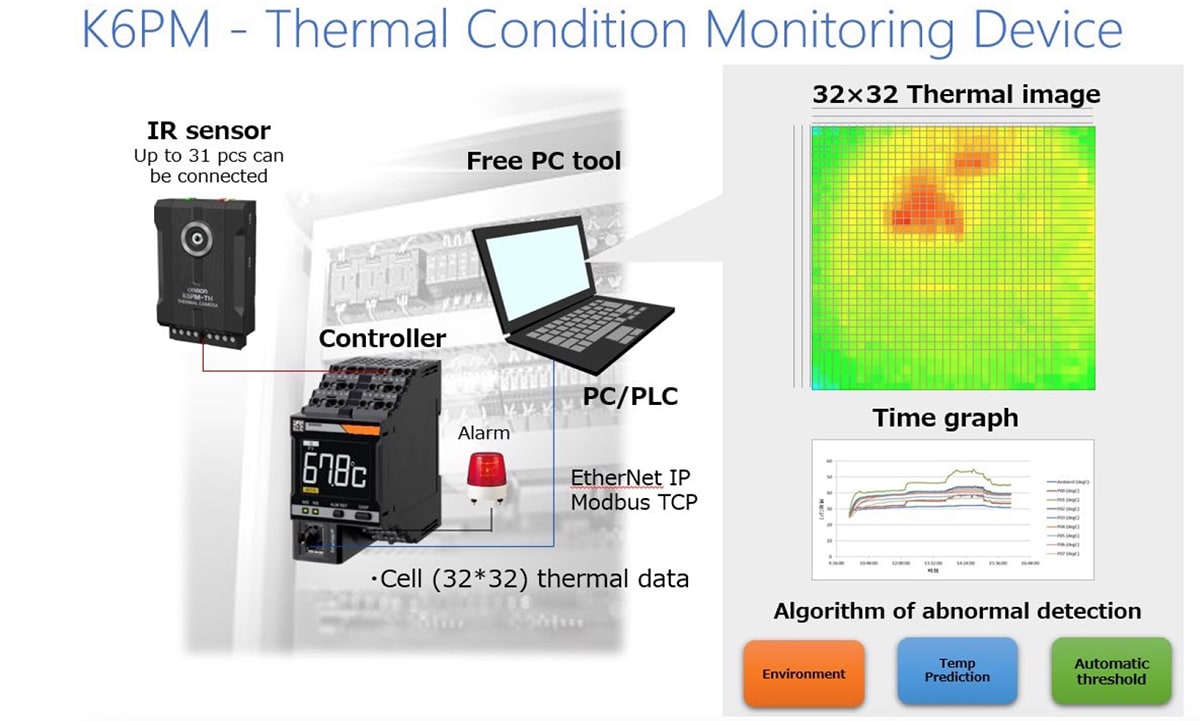
What we offer, instead of a traditional thermostat or thermistor, is a predictive maintenance product called the K6PM that’s based on an infrared thermal camera that you mount inside the panel door. This approach offers a number of advantages, because instead of looking at the overall ambient temperature inside the panel, you can actually map out all of the devices and components onto a grid with 16 different sensing areas, which allows you to monitor the upper and lower thermal limits for various products. Certain components, like solid-state relays for example, will run considerably hotter than standard relays.
Another advantage of using a thermal camera system like this is that you’re not just looking at one instance of temperature in time. The K6PM can also work out the rate of change, allowing you to review trends to decide whether a component is operating within its rated limits. And if you still find that it’s heating up too much, that gives you a very good indication that it’s going to fail from a predictive maintenance point of view.
Condition monitoring solutions with thermal cameras can also tune out the background temperature to better predict failures at a much earlier stage, which can be especially helpful in instances where a high ambient temperature is masking a component fault. And since these edge devices work on Ethernet/IP networks, they can send the calculations they’ve done with the data they’ve collected to your factory management system so you can schedule any downtime required for maintenance when it’s most convenient and cost effective.
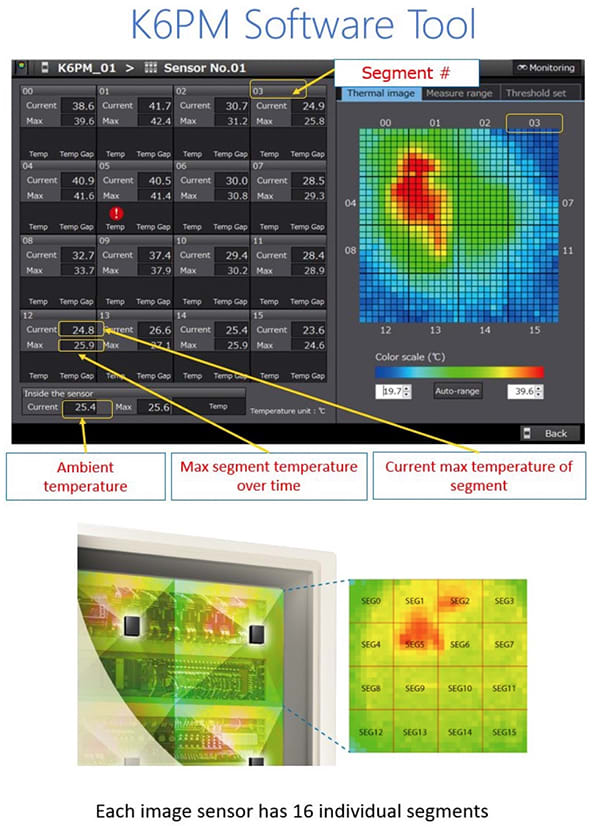
You mentioned that thermal damage within a control panel could lead to catastrophic failure. Is a control panel failure akin to a motor failure in terms of its potential for shutting down an entire production line?
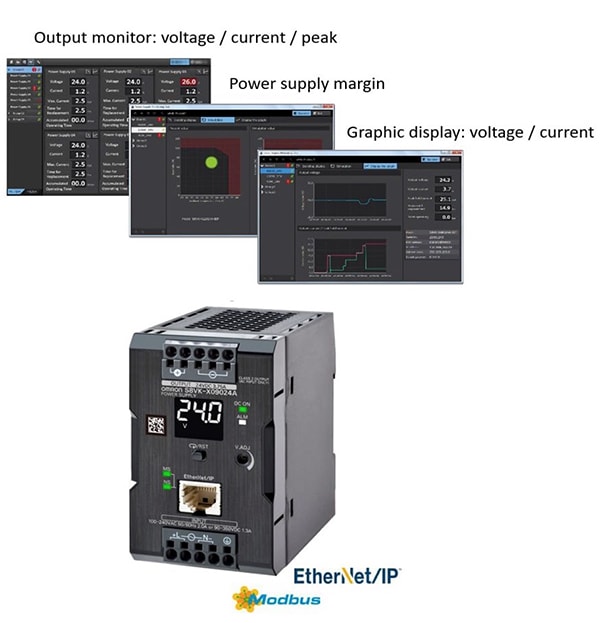
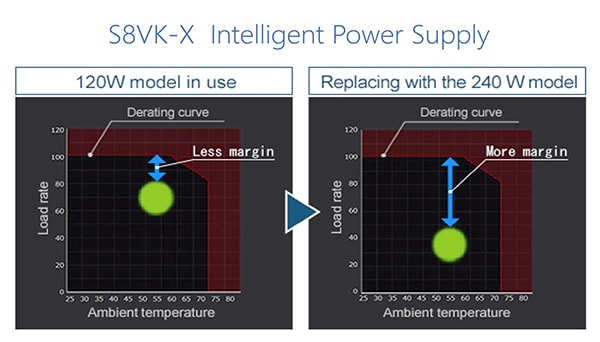
It is. That’s why we used the thermal imaging approach for our continuous condition monitoring equipment. If you open a panel door and use a thermal gun to test the components, all you’re going to get is a spot temperature at that moment in time rather than trends based on multiple data points over time, and that robust data is key to a predictive maintenance approach. For example, if you lose the power supply within a control panel, you may have a UPS backup that will give you enough time to safely shut down your equipment. But unlike a power outage that might resolve itself in a matter of minutes, a failed power supply isn’t going to come back online. It’s going to take down the panel, stopping your PLCs, your control processes and your system and bringing production in that area to a grinding halt until you’re able to replace that part.
Does OMRON offer any condition monitoring solutions for power supplies?
We do! Our S8VK-X is an IoT-enabled switch-mode power supply designed to support a new style of facility maintenance enabled by the visualization of power supplies.
The S8VK-X is fitted with an Ethernet/IP link that allows it to send a wide range of diagnostic data, including trend analysis, to a PLC or controller in your factory management system. It can identify the voltage, the current, the peak current and the load and can even tell you how long it’s been running. In addition, its corresponding software can be used to monitor multiple machines at once.
The reason this is important is because power supplies generally have a long service life. Under normal operation, you can typically expect 10 or 15 years from them. But few power supplies nearing the end of their life experience a catastrophic failure. Instead, the electrolytic capacitors within them start to break down, which can cause voltage fluctuations. Being able to sense these voltage fluctuations and identify that the power supply is failing at a very early stage allows users to replace the power supply when it’s most convenient and cost effective in terms of production rather than when it finally fails and stops production.
OMRON offers a number of solutions designed to monitor the temperature within the panel and the condition of individual interior components, including their draw on the power supply.
Additional Information
OMRON is a leading global supplier of industrial automation solutions with more than 75 years of manufacturing experience, a dedicated R&D program and a commitment to developing innovative products designed to improve the quality and efficiency of customers’ manufacturing operations. For more information about the OMRON’s condition monitoring solutions available through RS, please visit the embedded links throughout this article and listed below. For assistance identifying and deploying condition monitoring equipment and other predictive maintenance solutions, please contact your local RS representative at 1.866.433.5722 or reach out to the technical support team.
- OMRON Automation at RSElec.com
- OMRON Predictive Maintenance Products
- OMRON Power Products
- OMRON Predictive Maintenance Solutions Video
- OMRON Condition Monitoring Products
- OMRON K6PM Thermal Condition Monitor
- OMRON K6PM Thermal Condition Monitoring Brochure
- OMRON S8VK-X Switch-Mode Power Supply
- OMRON S8VK-X Switch Mode Power Supplies Brochure
